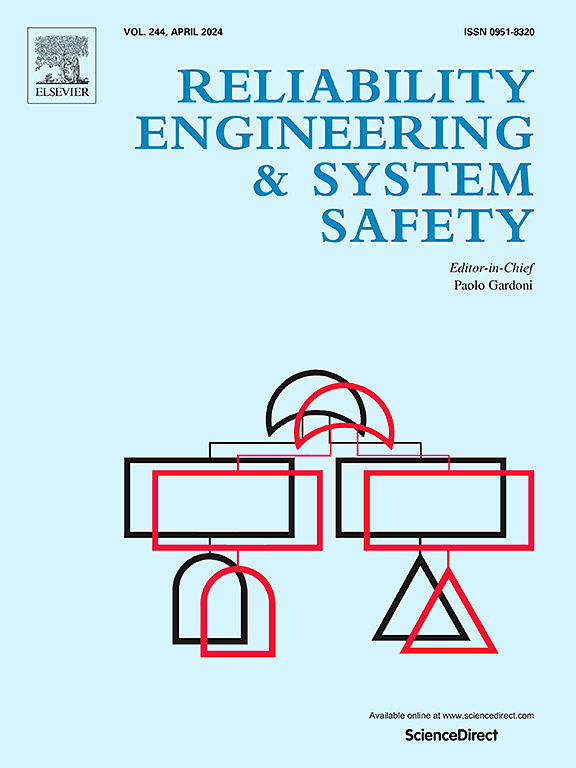Dynamic risk-informed verification prioritization for Complex Product Systems: A tri-metric approach using a Multi-State Hierarchical Bayesian Network
IF 9.4
1区 工程技术
Q1 ENGINEERING, INDUSTRIAL
引用次数: 0
Abstract
Complex Product Systems (CoPS) present unique challenges for Design Verification and Validation (V&V) due to tightly coupled, multi-disciplinary parameters and dynamic failure propagation. To address these challenges, this paper proposes a Multi-State Hierarchical Bayesian Network (MHBN) framework, coupled with a tri-metric approach — integrating the Degree of System Risk Reduction, Degree of System Performance Enhancement, and an Attribution Entropy measure. By reframing conventional failure mode analysis into hierarchical decomposition, fuzzy-driven probability modeling, and the formulation of a novel verification priority criterion, the method holistically captures interdependencies and uncertainties often overlooked by static approaches. In a case study on an automatic chemiluminescence immunoassay analyzer, empirical results and expert feedback revealed three key outcomes. First, the MHBN-based method distinguished mid-level components with clearer causal relationships as more cost-effective verification targets compared to top-level subsystems. Second, implementing the tri-metric guidance reduced total test hours by approximately 27% through strategic resource reallocation from high-entropy nodes to pivotal ones. Third, improved differentiation of critical priorities enabled early detection of design flaws — especially in the Pipette Mechanism — thus avoiding expensive rework. Overall, these findings underscore the value of integrating Bayesian inference with entropy concepts to support informed V&V decision-making in CoPS, offering a robust and adaptive alternative to conventional failure mode analysis.
复杂产品系统的动态风险知情验证优先级:使用多状态分层贝叶斯网络的三度量方法
由于紧密耦合、多学科参数和动态失效传播,复杂产品系统(cop)对设计验证和验证(V&;V)提出了独特的挑战。为了解决这些挑战,本文提出了一个多状态层次贝叶斯网络(MHBN)框架,结合三度量方法-集成系统风险降低程度,系统性能增强程度和属性熵度量。通过将传统的失效模式分析重构为层次分解、模糊驱动的概率建模和新的验证优先级标准的制定,该方法整体地捕获了静态方法经常忽略的相互依赖性和不确定性。在自动化学发光免疫分析分析仪的案例研究中,经验结果和专家反馈揭示了三个关键结果。首先,与顶层子系统相比,基于mhbn的方法将具有更清晰因果关系的中层组件区分为更具成本效益的验证目标。其次,通过从高熵节点到关键节点的战略性资源重新分配,实施三度量指导减少了大约27%的总测试时间。第三,关键优先级的改进区分能够早期发现设计缺陷——特别是在移液器机制中——从而避免昂贵的返工。总的来说,这些发现强调了将贝叶斯推理与熵概念相结合的价值,以支持cop中知情的V&;V决策,为传统的失效模式分析提供了一种鲁棒性和适应性的替代方案。
本文章由计算机程序翻译,如有差异,请以英文原文为准。
求助全文
约1分钟内获得全文
求助全文
来源期刊

Reliability Engineering & System Safety
管理科学-工程:工业
CiteScore
15.20
自引率
39.50%
发文量
621
审稿时长
67 days
期刊介绍:
Elsevier publishes Reliability Engineering & System Safety in association with the European Safety and Reliability Association and the Safety Engineering and Risk Analysis Division. The international journal is devoted to developing and applying methods to enhance the safety and reliability of complex technological systems, like nuclear power plants, chemical plants, hazardous waste facilities, space systems, offshore and maritime systems, transportation systems, constructed infrastructure, and manufacturing plants. The journal normally publishes only articles that involve the analysis of substantive problems related to the reliability of complex systems or present techniques and/or theoretical results that have a discernable relationship to the solution of such problems. An important aim is to balance academic material and practical applications.
 求助内容:
求助内容: 应助结果提醒方式:
应助结果提醒方式:


